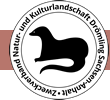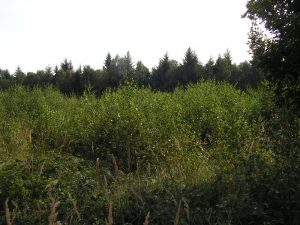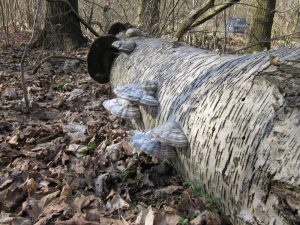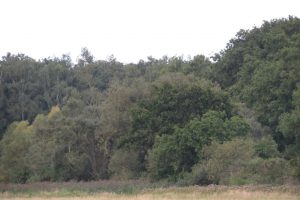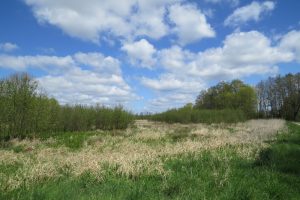Promoting indigenous species of trees and bushes
The core focus is forest conversion from non-indigenous tree populations and those which are unsuitable for their respective locations, for instance spruce, larch or hybrid poplar, to nearly natural, regionally typical forest communities, such as silver birch-alder forest, alder swamp forest, alder-ash forest or "Horstwald" forests consisting of oak and hornbeam. Also accepted here are so-called pioneer forest and transition stages, which are often composed of white birch and aspen, but also alder buckthorn, hazel and bird cherry. Furthermore, on the outside edges of the forests large areas of border strips have been planted, which are composed of various species of bushes, such as viburnum, sloe, hawthorn or spindle tree, whose blossoms catch the eye in spring.
Approving the maturing and aging processes
The forest areas that were acquired or planted by the special purpose association during the past years are not subject to forest management but are developed according to nature conservation criteria. This means that mature trees that would otherwise be ripe for felling remain in the forest stands, and through growing old and dying they create the characteristics of natural forests. Because of the small-scale structure that is facilitated, these processes only ever occur selectively and they create a diverse mosaic, consisting of different bushes and ground cover vegetation. The resulting microclimatic differences facilitate the development of extremely varied ecological networks of fungi, spiders and insects, as well as algae, mosses and lichens. The dying or dead large trees that remain in the Drömling nature park, particularly oak trees, have a special role to play here. For example, they provide a source of nutrition and a breeding habitat for black woodpeckers and middle spotted woodpeckers. Old woodpecker cavities serve as summer habitats or nursery roosts for bats, such as common noctules and brown long-eared bats. Xylobiont beetles (i.e. species of beetles that live in dead wood), which are now rare, depend on this standing or lying dead wood. The most well-known of these species is the stag beetle. Because of the low nutritional value of the dead tree, its larvae have to eat through the wood for five to eight years before they can emerge from their cocoons as the large beetle we know. To enable this, the old tree trunk must not rot and disintegrate before the end of this long development period. Standing dead wood is therefore better than lying, and strong wood is better than weak wood.
Establishing structure-rich, graduated forest edges
Today, most forest borders are structured as vertical broken edges without any transition to the adjacent areas that are used for agriculture. On the areas managed by the special purpose association, edge strips are therefore developed along the forests as transitional forest edge strips. These provide a habitat for a wide range of small birds, insects, reptiles and amphibious creatures. In conjunction with initial plantings, the intention is that bushes and shrubs with great structural diversity and biodiversity will develop here successionally. Other species to be found in these outer swathes of shrubberies include sloe, hawthorn, viburnum and spindle trees, as well as wild fruit. In the Drömling nature park, forest development is important from a nature conservation perspective. This is because the small area of the forests means that the typical forest interior climate, which is what essentially creates the valuable habitat quality, can only be achieved by shielding it from the outside environment.
Networking existing forest stands and establishing new ones
In many areas in the Drömling nature park, there is a mosaic of linear copse structures and smaller and larger field woods. By bridging the gaps, these can be developed into larger areas of forest. These suitable areas are mostly moist, which enables alder-swamp forest and alder-ash groves to grow. In conjunction with measures concerning the edge of the forest, initial plantings on approximately 80 hectares set the process of forest development in motion in many areas.
